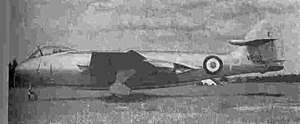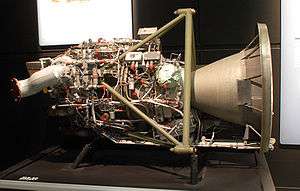Armstrong Siddeley Snarler
The Armstrong Siddeley ASSn. Snarler was a small rocket engine used for mixed-power experiments with an early turbojet engine.[2][3] and was the first British liquid-fuelled rocket engine to fly.[1] Unlike other British rocket engine projects that used hydrogen peroxide as an oxidiser, Armstrong Siddeley's used liquid oxygen. The rocket engine is described as having a dry weight of 215 lbf (960 N) thrust of 2,000 lbf (8.9 kN) and a specific fuel consumption of 20 (lb/h)/lbf thrust.[1] Work began in 1947 and the final configuration was first tested on 29 March 1950.[1]
| Country of origin | United Kingdom |
|---|---|
| Manufacturer | Armstrong Siddeley |
| Liquid-fuel engine | |
| Propellant | Liquid oxygen (LOX) / methanol/water |
| Pumps | Centrifugal, mechanically driven by external shaft drive from other engine. |
| Performance | |
| Thrust | 1,350–2,350 lbf (6.0–10.5 kN)[1] |
| Propellant capacity | LOX 75 imperial gallons (340 L), water-methanol 120 imperial gallons (550 L)[1] |
The prototype of the Hawker P.1040 Sea Hawk, VP 401, had a Snarler rocket of 2,000 lbf thrust added in its tail. The Rolls-Royce Nene turbojet, of 5,200 lbf thrust, had a split tailpipe which exhausted either side of the fuselage. The combination was termed the Hawker P.1072.[4][5]
This gave approximately[6] 50% greater thrust, although with twenty times the fuel consumption.[1] It was first used in flight on 20 November 1950, by Hawker's test pilot Trevor "Wimpy" Wade.[4] Half a dozen flights were made using the rocket motor before a minor explosion damaged the aircraft. Although methanol was used in the P.1072, jet fuel could be used for the Snarler. It was decided that reheat was a more practical proposition for boosting jet thrust than rockets.
An unusual feature of the engine was that the fuel/oxidiser pump was externally driven, by a drive from the gearbox of the P.1072's turbojet engine. This feature continued into the first versions of the subsequent Screamer engine, but was later replaced with a turbine-driven turbopump.[7]
Variants
- ASSn.1 Snarler
- The prototype and test engines, (Ministry of Supply designation ASSn.).
Specifications
Data from Aircraft engines of the World 1953,[8] Flight:6 August 1954:Armstrong Siddeley Snarler[9]
General characteristics
- Type: rocket engine booster
- Length: 94 in (2,400 mm) (overall length); 25.4 in (650 mm) (combustion chamber length)
- Diameter: 12.5 in (320 mm) (nozzle diameter)
- Dry weight: 215 lb (98 kg)
- Propellant capacity: 120 imp gal (140 US gal; 550 l) fuel; 75 imp gal (90 US gal; 340 l) oxidiser
- Fuel: 65% methanol, 35% water
- Oxidiser: liquid oxygen
Components
- Pumps: externally driven accessory gearbox mounted centrifugal pumps with de-aerators
Performance
- Thrust: 1,350–2,350 lbf (6.0–10.5 kN) at 20,000 ft (6,100 m) (dependent on main engine speed)
- Part thrust: 450–750 lbf (2.0–3.3 kN) at 20,000 ft (6,100 m) (dependent on main engine speed)
- Burn time:
- Thrust-to-weight ratio: 6.28–10.93 (part thrust: 2.09–3.49)
- Specific impulse: 195 seconds (1.91 km/s)
- Burn time: 2 minutes 45 seconds (Hawker P.1072 installation)
- Thrust specific fuel consumption: 20 lb/(lbf⋅h) (570 g/(kN⋅s))
References
- "Aero engines 1954". Flight: 447–448. 6 August 1954.
- S. Allen (7 December 1951). "Rockets for Aircraft Propulsion". The Aeroplane.
- "Snarler: Armstrong Siddeleys Oxygen Water-methanol Rocket Motor : Handling Liquid Oxygen". Flight: 92–93. 25 July 1952.
- "Armstrong Siddeley Snarler". Flight: 92–93. 25 July 1952.
- "The Quest for Power..." Flight: 444. 6 August 1954.
Transferring liquid oxygen from a B.O.C. spherical tanker to the Hawker P.1072 in which the Sn rocket was tested. The gas is exhausting through the lower vents and rapidly evaporating.
- Although the Nene's thrust, as for any turbojet, fell with increasing altitude the Snarler's remained constant.
- "Armstrong Siddeley Screamer". Flight: 160–164. 27 July 1956.
- Wilkinson, Paul H. (1953). Aircraft engines of the World 1953 (11th ed.). London: Sir Isaac Pitman & Sons Ltd.
- "Armstrong Siddeley Snarler:THE DEVELOPMENT OF A PUMP-FED LIQUID-FUEL AIRCRAFT ROCKET". Flight. 66 (2376): 176–180. 6 August 1954. Retrieved 7 January 2019.

